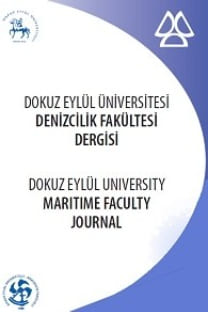KRUVAZİYER YOLCULARIN LİMAN ALANINDA SATIN ALMA DAVRANIŞLARINA İLİŞKİN BİR ARAŞTIRMA
A RESEARCH ON PURCHASING BEHAVIOR OF CRUISE PASSENGERS AT PORTS
___
- ATLAY, D. _(2003) Limanların Ekonomik Etkilerinin Değerlendirilmesi Üzerine Bir Inceleme, Dokuz Eylül Üniversitesi Sosyal Bilimler Enstitüsü. İzmir, Yayınlanmamış Yüksek Lisans Tezi.
- AVRAHAM, E. ve KETTER, E. (2008) Improving the Image of Cities, Countries, and Tourist Destinations Media Strategies for Marketing Places in Crisis, Butterworth Heinemann, Oxford, UK.
- BACKSTRÖM, K. (2013) Adventures, Auctions and Aspirations: Illuminating Shifts, Tensions and Contradictions in Consumers’ Leisure Shopping Experiences, The International Review of Retail Distribution and Consumer Research, Vol.23, No.1, pp. 65-86.
- BRIDA, J., PULINA, M., RIANO, E., ZAPATA-AGUIRRE, S. (2012) Cruise Passengers’ Experience Embarking in Caribbean Home Port: The Case Study of Cartagena de Indias, Ocean Coastal Management, 55: 135- 145.
- CLIA (201 1) 2011 CLIA Cruise Market Overview: Statistical Cruise Industry Data Through 2010. http://cruising.org/regulatory/clia-statistical-reports, Erişim Tarihi: 15.12.2013.
- DAVIS, H.C. (1983) Regional Port Impact Studies: Critique and Suggested Methodology, Transportation Journal, Vol. 23, No. 2, Penn State University Press, pp. 61-71.
- DENIZ TICARETI GENEL MÜDÜRLÜĞÜ (2014) Kruvaziyer İstatistikleri. https://atlantis.denizcilik.gov.tr/istatistik/istatistik_kruvaziyer.aspx Erişim Tarihi: 17.01.14
- DİLBER, İ. (2007) Turizm Sektörünün Türkiye Ekonomisi Üzerindeki Etkisinin Girdi-Çikti Tablosu Yardımıyla Değerlendirilmesi, Celal Bayar Universitesi İİBF Yönetim ve Ekonomi Dergisi, Cilt: 14, Sayı: 2, s. 205-220.
- DOUGLAS, N. ve DOUGLAS, N. (2004) Cruise Ship Passenger Spending Patterns in Pacific Island Ports, International Journal of ourisim Research, 6, pp. 251—261.
- FORSTYH, P. ve DWYER, L. (1998) Economic Significance of Cruise Tourism, Annals of Tourism Research, Vol. 25, No. 2, pp. 393-415.
- ECC (2013) European Cruise Council 2012-2013 Report, Editor: Chris Ashcroft, Contributors: Peisley, T. McLaughlin, J. http ://WWW.europeancruisecouncil.com/content/ECC%2OReport%2020 2- 13de Erişim Tarihi: 26.11.2013.
- ESER, S. (2006) Eastern Mediterranean Cruise Shipping and Marketing Strategies for Turkey. Dokuz Eylül University, School of Maritime Business and Management, Department of Maritime Business Administration. Izmir, Unpublished Diploma Project.
- EUROPEAN CRUISE COUNCIL (2011) The Cruise Industry: Leader in Europe’s Economic Recovery Edition Contribution of Cruise Tourism to the Economies of Europe, G.P. Wild (International) Limited and Business Research Economic Advisors.
- GLOBAL LIMAN İŞLETMELERİ (2014) Liman Kitabı http://WWW.globalports.com.tr/pdf/liman_kitabi.pdf Erişim Tarihi: 17.01 14 GÜNEŞ, M. (2013) Kruvaziyer Turizminde Dünya ve İzmir, Türkiye Kruvaziyer Platformu’nun Çalışmaları, İzmir Ticaret Odası Pusula Dergisi, Sayı: 2013/04, s. 1-5, http://WWW.izto.org.tr/e-oda/pusula-dergisi/pusula2013/2013-04.
- GÜNLÜ, E., CERİT, A. G. PIRNAR, İ., ORAL, E. Z., AKTAS, G.,
- DOLOGH, G., BALTAZZİ, A. (2007) Izmir as an Emerging Destination in Cruise Tourism: An Analysis of Cruise Passengers’ Experiences and Perceptions, Conference on Cruise Shipping Opportunities and Challenges: Markets, Technologies and Local Development, Naples, 4-6 October 2007, Proceedings in CD.
- HENTHORNE, L., GEORGE, B. P., SMITH, W.C. (2013) Risk Perception and Buying Behavior: An Examination of Some Relationships in the Context of Cruise Tourism in Jamaica, International Journal of Hospitality Tourism Administration, 14, pp: 66—86.
- HEUNG, S. ve CHENG, E. (2000) Assessing Tourists' Satisfaction With Shopping in the Hong Kong Special Administrative Region of China, Journal of Travel Research, 38: 396.
- KAHN, R. F. (1931) The Relation of Home Investment to Unemployment, The Economic Journal, Vol. 41, No. 162 pp: 173-198.
- KARAKAYALI, H. (1995) Makro Ekonomi, Bilgehan Yayınevi, Izmir.
- KUŞADASI TİCARET ODASI (2013) Dünyada ve Türkiye ’de Kruvaziyer Turizmi ve Kuşadası Limanı, http://WWW.kuto.org.tr/img/ku/raporlar/10.pdf, Erişim Tarihi:05.12.2013.
- LARSEN, S., WOLFF, K., MARNBURG, E., OGAARD, T. (2013) Belly Full, Purse Closed Cruise Line Passengers Expenditures, Tourism Management Perspectives, 6: 142-148.
- MUCUK, İ. (2010) Pazarlama İlkeleri, Türkmen Kitabevi, İstanbul. PARLAK, İ. (2008) Perceptions of Bazaar Retailers on Cruise Shipping Passengers: Comparative Case Study For Istanbul and Izmir, Dokuz Eylul University School of Maritime Business and Management. Izmir, Unpublished Diploma Project.
- REISINGER, Y. (2009) International Tourism Culture and Behavior, Butterworth Heinemann, Oxford, UK.
- SEYİDOĞLU, H. (2003) Uluslararası İktisat Teori Politika ve Uygulama, Güzem Can Yayınları, İstanbul.
- STEFANIDAKI, E. ve LEKAKOU, M. (2012) Generated Economic Impact on Cruise Destinations: The Piraeus Case, Cruise Tourism and Society. Eds.: Alexis Papathanassis, Tihomir Lukovic, Michael Vogel. Berlin Heidelberg: Springer-Verlag.
- T.C. ULAŞTIRMA DENİZCİLİK VE HABERLEŞME BAKANLIĞI, (2014) https://atlantis.udhb.gov.tr/istatistik/istatistik_kruvaziyer. aspx Erişim tarihi:18.01.2014.
- TEYE, V.B. ve LECLERC, D.(1998) Product and Service Delivery Satisfaction Among North American Cruise Passengers, Tourism Management, Vol. 19, N0. 2, pp. 153-160.
- TIMOTHY, J. ve Butter, W. (1995) Cross-Border Shopping: North American Perspective, Annals of Tourism Research, Vol. 22, No. 1, pp. 16- 34.
- TUNCER, B., ATLAY IŞIK, D. (2013) Havalimanı Yolcularının Satın Alma Davranışlarını İncelemeye Yönelik Bir Alan fflraştırması, 18. Ulusal Pazarlama Kongresi 19-22 Haziran 2013. Kafkas Universitesi, Kars.
- ISSN: 1309-4246
- Yayın Aralığı: 2
- Başlangıç: 2009
- Yayıncı: Dokuz Eylul Üniversitesi Matbası
SUALTI ARKEOPARKLARI VE DENİZ TURİZMİ
TURİZM YAZININDA “DENİZ TURİZMİ”NİN OLGUSAL GELİŞİMİ
Gökçe Yasemin KOZANL, Sami Sonat OZDEMIR, Ebru ÜNLÜ
Kruvaziyer Yolcuların Liman Alanında Satın Alma Davranışlarına İlişkin Bir Araştırma
Görkem DİKEÇ, Yavuz BAYAR, Güldem CERİT
YAT SATIN ALMA KARARINDA YAT TİPİ TERCİHİ: IC ÇEŞME MARİNA'DAKİ YAT SAHİPLERİ ÜZERİNDE BİR UYGULAMA
TURİZM AMAÇLI SU ALTI VE SU ÜSTÜ SPORTİF FAALİYETLER: BUGÜNÜ GELECEĞİ
KRUVAZİYER YOLCULARIN LİMAN ALANINDA SATIN ALMA DAVRANIŞLARINA İLİŞKİN BİR ARAŞTIRMA
Görkem DİKEÇ, Yavuz BAYAR, A. Güldem CERİT
YAT SATIN ALMA KARARINDA YAT TİRİ TERCİHİ: IC ÇEŞME MARİNA’DAKİ YAT SAHİPLERİ UZERINDE BİR UYGULAMA
GULET TATİLİ VE KADINLARIN GULET TATİLİ SATIN ALMA TERCİHLERİ ÜZERİNE BİR ARAŞTIRMA
TURİZM YAZININDA "DENİZ TURİZMİ"NİN OLGUSAL GELİŞİMİ
Yasemin KOZAN, Gökçe Yasemin KOZAN, Sami ÖZDEMİR, Sami Sonat ÖZDEMİR, Ebru GÜNLÜ
